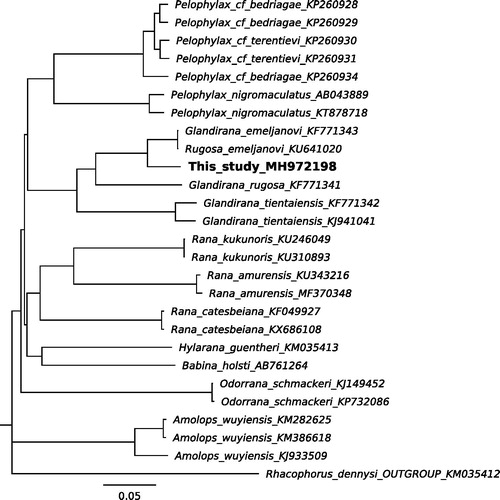Abstract
The Glandirana emeljanovi is a frog known to live in northeastern China and the Korean peninsula, but the taxonomic identity of animals from Korea is still uncertain. Here, we first determined the complete mitochondrial genome sequence of G. emeljanovi in Korea. The genome was 17,668 bp in length, consisting of 13 protein-coding genes, two rRNAs, 22 tRNAs, and a control region. The genetic analysis of available Ranidae mitogenomes supports that the genus Glandirana is monophyletic and that Korean G. emeljanovi is the same species as Chinese G. emeljanovi and is a different species from Japanese G. rugosa.
The Glandirana emeljanovi is a frog known to be distributed in northeastern China and the Korean peninsula (Kuzmin et al. Citation2004). The Glandirana rugosa in Japan and G. emeljanovi were considered to be the same species in the past, but Dubois (Citation1992) classified them as separate independent species. This classification on the basis of phenetic criteria, however, differs from the modern frog classification (Frost Citation2018) in that it places these species in Rana (Rugosa) rather than Glandirana. In addition, since this classification has a limit of mainly considering morphology and anatomical characteristics, there is a growing demand for classification studies by molecular data. Studies on mitogenome of Japanese G. rugosa and Chinese G. emeljanovi have been conducted (Xia et al. Citation2014; Liu et al. Citation2017) but mitogenome of Korean G. emeljanovi has not yet been determined. Particularly, the IUCN Redlist (Kuzmin et al. Citation2004) states that the identity of G. emeljanovi living on the Korean peninsula remains still unclear. Thus, we announced mitogenome of Korean G. emeljanovi and compared it with those of Chinese G. emeljanovi, Japanese G. rugosa, and related species to provide new information on their taxonomic identity.
We collected an individual of G. emeljanovi in Seoul, Korea (Latitude, 37.457930; Longitude, 126.947674) and stored its tissue in Dr. Eo lab, Kongju National University (sample database number: ESH_A00042). We extracted DNA from the tissue and produced sequence reads of 2.48 Gbp in total length using the Illumina HiSeq 2500 PE100 platform. We assembled a mitogenome from the sequence reads using Geneious v.10.2.5. and annotated it with help of related species and MITOS Web Server (Bernt et al. Citation2013).
The complete mitogenome of Korean G. emeljanovi was 17,668 bp in length (GenBank accession number: MH972198), slightly shorter than the mitogenome of Chinese G. emeljanovi (17,733 bp, Liu et al. Citation2017). The mitogenome structure of Korean G. emeljanovi is consistent with that of the typical Glandirana mitogenome in that it consists of 13 protein-coding genes (PCGs), 12S and 16S rRNAs, 22 tRNAs, and a control region with ND6 and eight tRNAs encoded on the light strand and the other genes on the heavy strand (Xia et al. Citation2014; Liu et al. Citation2017). The neighbor-joining tree constructed from 13 PCGs of Korean G. emeljanovi and available major Ranidae frogs in GenBank supports the monophyly of the genus Glandirana (). Also, our results support Frost (Citation2018) that recognize the clade of Glandirana and Rugosa as one genus, Glandirana, placing Rugosa into synonomy. Genetic identity of mitogenomes between Korean and Chinese G. emeljanovi was 94.0% while genetic identity between Korean G. emeljanovi and Japanese G. rugosa was 84.0%. The range of intraspecific genetic identity in the Ranidae frogs analyzed was 94.0–100.0%. Taking this into consideration, our results support a modern frog classification system (Frost Citation2018) in which Korean G. emeljanovi is the same species as Chinese G. emeljanovi and is a different species from Japanese G. rugosa.
Disclosure statement
No potential conflict of interest was reported by the authors.
Additional information
Funding
References
- Bernt M, Donath A, Jühling F, Externbrink F, Florentz C, Fritzsch G, Pütz J, Middendorf M, Stadler PF. 2013. MITOS: improved de novo metazoan mitochondrial genome annotation. Mol Phylogenet Evol. 69:313–319.
- Dubois A. 1992. Notes on the classification of Ranidae (Amphibians Anura) [Notes surla clasification des Ranidae (Amphibiens Anoures)]. Bulletin Mensuel de la SocieteLinneenne de Lyon. 61:305–352.
- Frost DR. 2018. Amphibian Species of the World: an Online Reference. Version 6.0. American Museum of Natural History (US). [accessed 2018 Sep 27]. http://research.amnh.org/herpetology/amphibia/index.html.
- Kuzmin S, Matsui M, Zhao W, Kaneko Y. 2004. Glandirana emeljanovi. The IUCN Red List of Threatened Species 2004: e.T58591A11793116. [Accessed 2018 Dec 4]. http://dx.doi.org/10.2305/IUCN.UK.2004.RLTS.T58591A11793116.en.
- Liu W, Tao J, Wang H, Zhao W, Liu P. 2017. Sequencing and analysis of the complete mitochondrial genome of Rugosa emeljanovi (Anura: Ranidae). Mitochondrial DNA B. 2:383–384.
- Xia Y, Zheng Y, Miura I, Wong PB, Murphy RW, Zeng X. 2014. The evolution of mitochondrial genomes in modern frogs (Neobatrachia): nonadaptive evolution of mitochondrial genome reorganization. BMC Genom. 15:691

